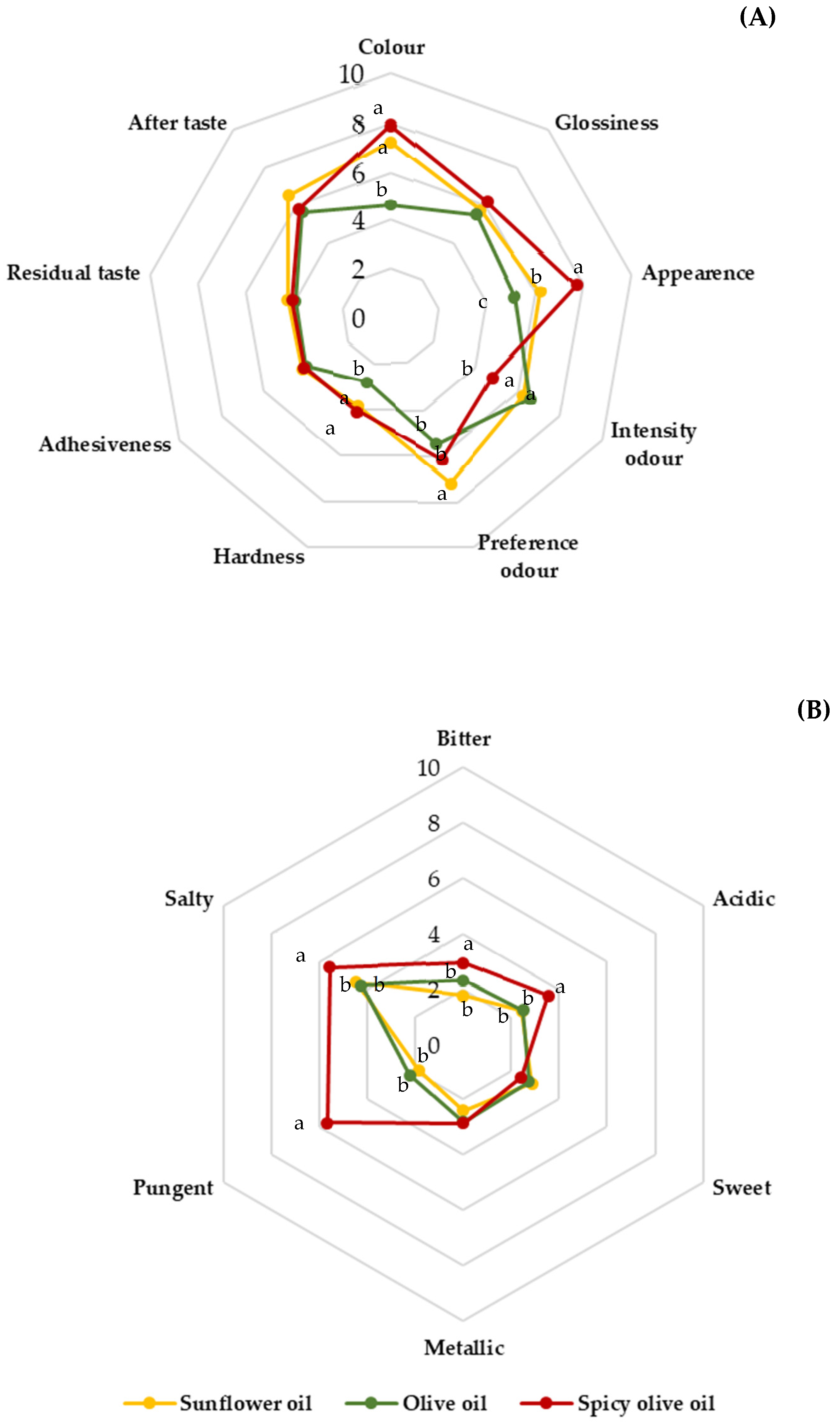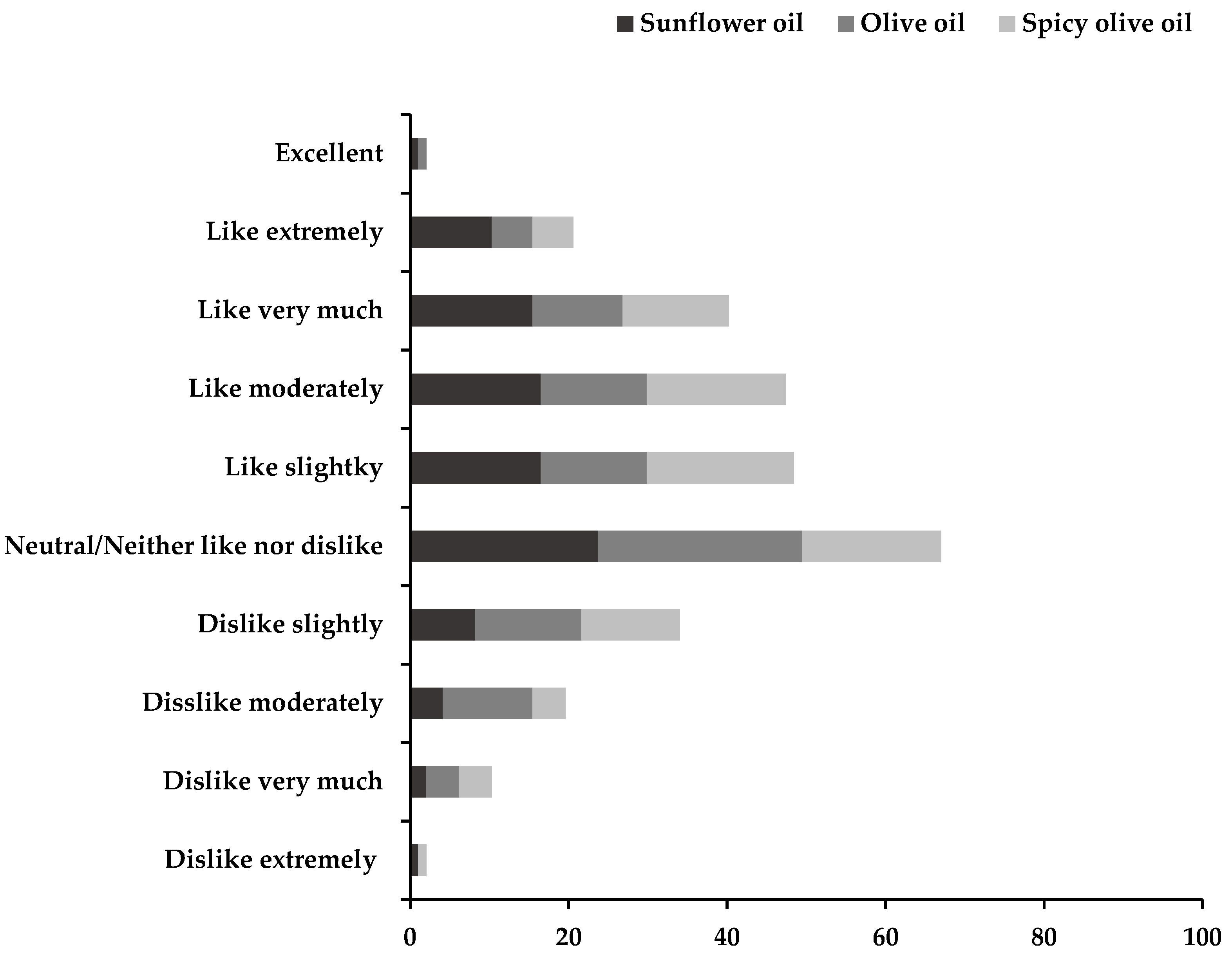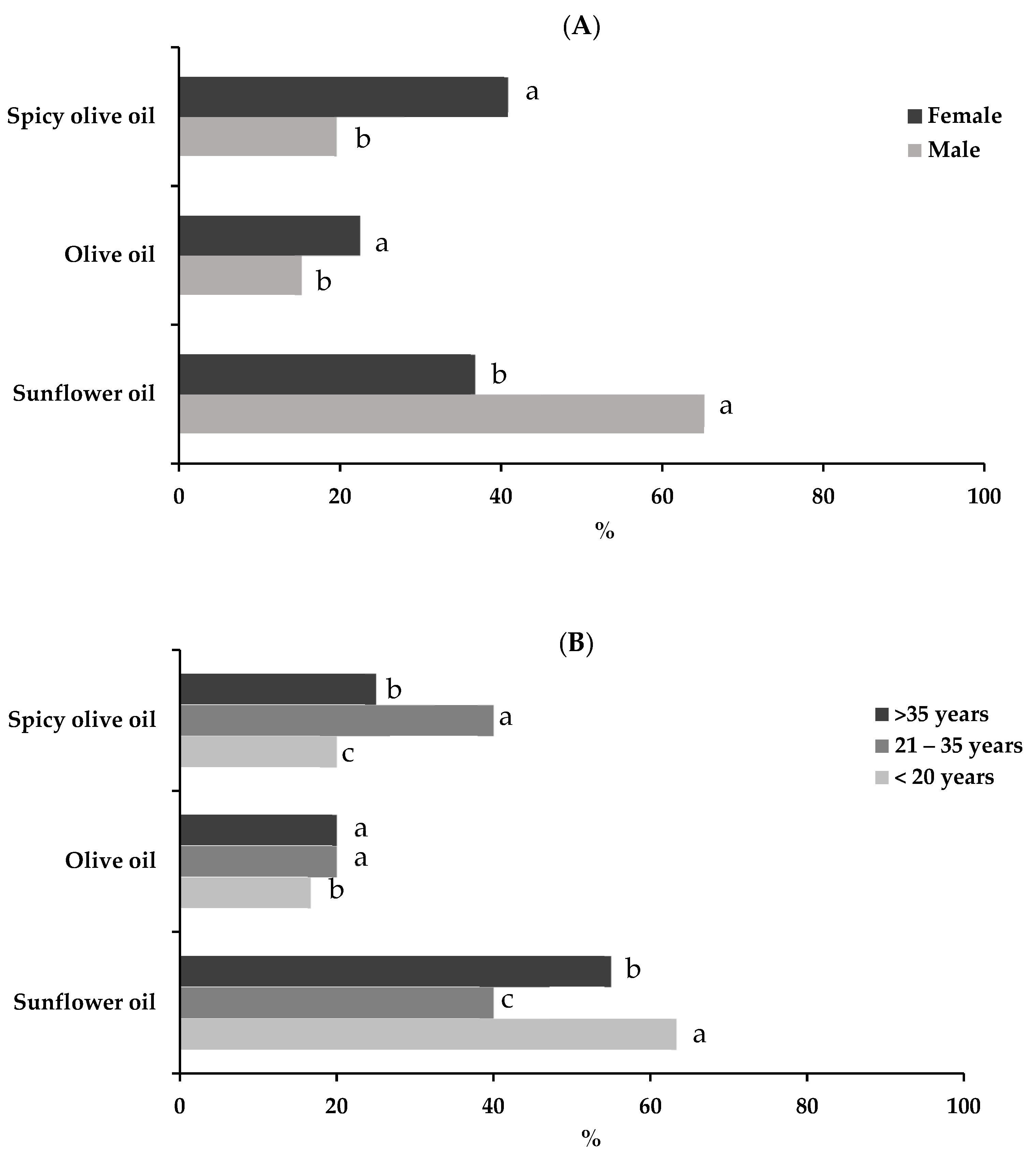Impact of the Filling Medium on the Colour and Sensory Characteristics of Canned European Eels (Anguilla anguilla L.)
Abstract
:1. Introduction
2. Materials and Methods
2.1. Samples and Fish Preparation
2.1.1. Samples Preparation
2.1.2. Eel Canning Process
2.1.3. Storage
2.2. Colour Determination
2.3. Sensorial Analyses
2.3.1. Descriptive Sensory Evaluation
2.3.2. Consumer Tests
2.4. Statistical Analysis
3. Results and Discussion
3.1. Colour
3.2. Sensorial Analysis
3.2.1. Sensory Description
3.2.2. Consumer Preference
4. Conclusions
Author Contributions
Funding
Informed Consent Statement
Data Availability Statement
Acknowledgments
Conflicts of Interest
References
- Wilkinson, C.; Dijksterhuis, G.B.; Minekus, M. From food structure to texture. Trends Food Sci. Technol. 2000, 11, 442–450. [Google Scholar] [CrossRef]
- Spence, C. On the psychological impact of food colour. Flavour 2015, 4, 21–47. [Google Scholar] [CrossRef] [Green Version]
- Abdulla, M.Z.; Guan, L.C.; Lim, K.C.; Karim, A.A. The application of computer vision and tomographic radar imaging for assessing physical properties of food. J. Food Eng. 2004, 61, 125–135. [Google Scholar] [CrossRef]
- Leon, K.; Mery, D.; Pedreschi, F.; Leon, J. Colour measurement in L*a*b* units from RGB digital images. Food Res. Int. 2006, 39, 1084–1091. [Google Scholar] [CrossRef]
- Pathare, P.B.; Opara, U.L.; Al-Julanda Al-Said, F. Color Measurement and analysis in fresh and processed foods: A review. Food Bioprocess Technol. 2013, 6, 36–60. [Google Scholar] [CrossRef]
- Trusell, H.J.; Saber, E.; Vrhel, M. Color image processing. IEEE Signal Process. Mag. 2005, 22, 14–22. [Google Scholar] [CrossRef]
- Morsy, M.K. Quality enhancement of canned little tunny fish (Euthynnus alletteratus) by whitening solutions, pre-cooking time and filling medium. J. Food Process. Technol. 2016, 7, 632. [Google Scholar] [CrossRef] [Green Version]
- Medina, I.; Sacchi, R.; Biondi, L.; Aubourg, S.P.; Paolillo, L. Effect of packing media on the oxidation of canned tuna lipids. Antioxidant effectiveness of extra virgin olive oil. J. Agric. Food Chem. 1998, 46, 1150–1157. [Google Scholar] [CrossRef]
- Cobo, F.; Hernández, J.S.; Vieira, R.; Servia, M.J. Seasonal downstream movements of the European eel in a Southwestern Europe river (River Ulla, NW Spain). Nova Acta Científica Compostel. 2014, 21, 77–84. [Google Scholar]
- UNE-ISO 4121:2006; Sensory Analysis—Guidelines for the Use of Quantitative Response Scales. ISO: Geneva, Switzerland, 2006.
- ISO 11035:1994; Sensory Analysis—Identification and Selection of Descriptors for Establishing a Sensory Profile by a Multidimensional Approach. International Organization for Standardization (ISO): Geneva, Switzerland, 1994.
- UNE-ISO 6658:2005; Sensory Analysis. Methodology. General Guidance. International Organization for Standardization (ISO): Geneva, Switzerland, 2008.
- UNE-EN-ISO 5492:2010/A1:2017; Sensory Analysis—Vocabulary—Amendment 1. International Organization for Standardization (ISO): Geneva, Switzerland, 2017.
- Huang, M.C.; Cho, S.C.; Ochiai, Y.; Watabe, S. Evaluation of biochemical properties of burnt and normal meat in pacific bluefin tuna (Thunnus orientalis). Int. J. Nutr. Food Sci. 2017, 6, 203–210. [Google Scholar] [CrossRef] [Green Version]
- Fuentes-Zaragoza, E.; Pérez-Alvarez, J.A.; Sánchez-Zapata, E. Effect of ingredients concentration upon colour of heat treated hake (Merluccius australis) batters. Ópt. Pura Apl. 2009, 324, 9–21. [Google Scholar]
- Sánchez-Zapata, E.J.; Pérez-Álvarez, J.A.; Fernández-López, J.; Barber-Valles, X. Descriptive study of reflectance spectra of Hake (Merluccius australis), Salmon (Salmo salar) and light and dark muscle from Tuna (Thunnus thynnus). J. Food Qual. 2010, 33, 391–403. [Google Scholar] [CrossRef]
- Chaijan, M.; Benjakul, S.; Visessanguan, W.; Faustman, C. Changes of pigments and colour in sardine (Sardinella gibbosa) and mackerel (Rastrelliger kanagurta) muscle during iced storage. Food Chem. 2005, 93, 607–617. [Google Scholar] [CrossRef]
- Sikorski, E.; Kolakowska, A.; Sun-Pan, B. Composición nutritiva de los principales grupos de organismos alimenticios marinos. In Tecnología de los Productos del Mar: Recursos, Composición Nutritiva y Conservación; Sikorski, E., Ed.; Acribia: Zaragoza, Spain, 1994; pp. 41–70. [Google Scholar]
- Ersus, S.; Yurdagel, U. Microencapsulation of anthocyanin pigments of black carrot (Daucus carota L.) by spray drier. J. Food Eng. 2007, 80, 805–812. [Google Scholar] [CrossRef]
- Sánchez-Gimeno, A.C.; Negueruela, A.I.; Benito, M.; Vercet, A.; Oria, R. Some physical changes in Bajo Aragón extra virgin olive oil during the frying process. Food Chem. 2008, 110, 654–658. [Google Scholar] [CrossRef]
- Kusucharid, C.; Jangchud, A.; Thamakorn, P. Changes in characteristics of palm oil during vacuum and atmospheric frying conditions of sweet potato. Kasetsart J. (Nat. Sci.) 2009, 43, 298–304. [Google Scholar]
- Krokida, M.K.; Maroulis, Z.B.; Saravacos, G.D. The effect of the method of drying on the colour of dehydrated products. Int. J. Food Sci. Technol. 2001, 36, 53–59. [Google Scholar] [CrossRef]
- Perez-Palacios, T.; Casal, S.; Petisca, C.; Ferreira, I.M. Nutritional and sensory characteristics of bread-coated hake fillets as affected by cooking conditions. J. Food Qual. 2013, 36, 375–384. [Google Scholar] [CrossRef]
- Haard, N.F. Biochemistry and chemistry of color and color changes in sea foods. In Advances in Seafood Biochemistry: Composition and Quality; Flick, G.J., Martin, R.E., Eds.; Technomic Publishing Company: Lancaster, PA, USA, 1992; pp. 305–360. [Google Scholar]
- Gómez, B.; Munekata, P.E.S.; Gavahian, M.; Barba, F.J.; Martí-Quijal, F.J.; Bolumar, T.; Bastianello Campagnol, P.C.; Tomasevic, I.; Lorenzo, J.M. Application of pulsed electric fields in meat and fish processing industries: An overview. Food Res. Int. 2019, 123, 95–105. [Google Scholar] [CrossRef]
- Cropotova, J.; Tappi, S.; Genovese, J.; Rocculi, P.; Rosa, M.D.; Rustad, T. The combined effect of pulsed electric field treatment and brine salting on changes in the oxidative stability of lipids and proteins and color characteristics of sea bass (Dicentrarchus labrax). Heliyon 2021, 7, e05947. [Google Scholar] [CrossRef]
- Maskan, M. Change in colour and rheological behaviour of sunflower seed oil during frying and after adsorbent treatment of used oil. Eur. Food Res. Technol. 2003, 218, 20–25. [Google Scholar] [CrossRef]
- Pedreschi, F.; Moyano, P.; Kaack, K.; Granby, K. Color changes and acrylamide formation in fried potato slices. Food Res. Int. 2005, 38, 1–9. [Google Scholar] [CrossRef]
- Kaynak, G.; Ersoz, M.; Kara, H. Investigation of the properties of oil at the bleaching unit of an oil refinery. J. Colloid Interface Sci. 2004, 280, 131–138. [Google Scholar] [CrossRef] [PubMed]
- Morello, J.R.; Motilva, M.J.; Tovar, M.J.; Romero, M.P. Changes in commercial virgin olive oil (cv. Arbequina) during storage, with special emphasis on the phenolic fraction. Food Chem. 2004, 85, 357–364. [Google Scholar] [CrossRef]
- Reda, S.Y. Comparative Study of Vegetable Oils Subjected to the Thermal Stress. Master’s Dissertation, Universidade Estadual de Ponta Grossa, Ponta Grossa, Brasil, 2004. [Google Scholar]
- Criado, M.N.; Romero, M.P.; Casanovas, M.; Motilva, M.J. Pigment profile and colour of monovarietal virgin olive oils from Arbequina cultivar obtained during two consecutive crop seasons. Food Chem. 2008, 110, 873–880. [Google Scholar] [CrossRef]
- Myrland, O.; Trondsen, T.; Johnson, R.S.; Lund, E. Determinants of seafood consumption in Norway: Lifestyle, revealed preferences and barriers to consumption. Food Qual. Prefer. 2000, 11, 169–188. [Google Scholar] [CrossRef]
- Spence, C. What is so unappealing about blue food and drink? Int. J. Gastronomy Food Sci. 2018, 14, 1–8. [Google Scholar] [CrossRef]
- Cheng, J.H.; Sun, D.W.; Han, Z.; Zeng, X.A. Texture and structure measurements and analyses for evaluation of fish and fillet freshness quality: A review. Compr. Rev. Food Sci. Food Saf. 2014, 13, 52–61. [Google Scholar] [CrossRef]
- Gómez-Limia, L.; Franco, I.; Martínez-Suárez, S. Effects of processing step, filling medium and storage on amino acid profiles and protein quality in canned European eels. J. Food Comp. Anal. 2021, 96, 103710. [Google Scholar] [CrossRef]
- Green, B.G.; Hayes, J.E. Capsaicin as a probe of the relationship between bitter taste and chemesthesis. Physiol. Behav. 2003, 79, 811–821. [Google Scholar] [CrossRef]
- ISO 8587:2006; Sensory Analysis-Methodology-Ranking. International Organization for Standardization (ISO): Geneva, Switzerland, 2006.
- Wansink, B.; Cheney, M.M.; Chan, N. Exploring comfort food preferences across age and gender. Physiol. Behav. 2003, 79, 739–747. [Google Scholar] [CrossRef]
- Spence, C.; Velasco, C.; Knoeferle, K. A large sample study on the influence of the multisensory environment on the wine drinking experience. Flavour 2014, 3, 8. [Google Scholar] [CrossRef] [Green Version]
- Da Silva, L.A.; Lin, S.M.; Teixeira, M.J.; de Siqueira, J.T.T.; Filho, W.J.; de Siqueira, S.R.D.T. Sensorial differences according to sex and ages. Oral Dis. 2014, 20, e103–e110. [Google Scholar] [CrossRef] [PubMed]
- Mojet, J.; Christ-Hazelhof, E.; Heidema, J. Taste perception with age: Generic or specific losses in threshold sensitivity to the five basic tastes? Chem. Senses 2001, 26, 845–860. [Google Scholar] [CrossRef] [Green Version]







| Descriptor | Definition |
|---|---|
| External aspect | |
| Colour | Attribute of products inducing a colour sensation. Colour ranging from white to brownish |
| Glossiness | The amount of light reflected from the muscle, ranging from dull to glossy |
| Appearance | All the visible attributes of fish |
| Texture in mouth | |
| Hardness | Force required to achieve a given deformation, penetration, or breakage of the fish muscle. |
| Adhesiveness | Force required to remove the muscle with tongue that sticks to the mouth or to a substrate. |
| Residual taste | Sensation perceived whilst the product was in the mouth. |
| Aroma | |
| Preference | Preference between two or more samples. |
| Intensity | Perceived strength at differing concentrations of certain volatile compounds |
| Taste | |
| Bitter | The intensity of the taste associated with dilute aqueous solutions of various substances such as quinine or caffeine |
| Acid | Taste associated with aqueous solutions of most acid substances such as citric acid. |
| Sweet | Taste associated with aqueous solutions of sugar such as sucrose, or aspartame. |
| Salty | The intensity of the taste associated with salt solutions |
| Pungent | An irritating, sharp sensation, or piercing sensation in the buccal and nasal mucous membranes |
| Metallic | Taste associated with flavour reminiscent of metal, slightly oxidized metal, or salts. |
| Aftertaste | Sensation that occurs after elimination of the product |
| L* | a* | b* | H° | C* | ΔE | ||
|---|---|---|---|---|---|---|---|
| Raw | 74.05 ± 0.24 a | −4.95 ± 0.13 ac | 14.60 ± 0.18 a | 108.74 ± 0.55 a | 15.15 ± 0.35 a | -- | |
| Frying | Sunflower oil | 72.68 ± 1.63 b | −5.12 ± 0.20 ab | 16.69 ± 0.36 c | 108.08 ± 1.67 a | 17.56 ± 0.21 b | 10.78 ± 0.30 ab |
| Olive oil | 71.94 ± 1.89 b | −4.72 ± 0.51 acd | 19.56 ± 0.34 de | 103.56 ± 1.18 b | 20.13 ± 0.45 c | 11.17 ± 0.23 a | |
| Sterilization | Sunflower oil | 77.61 ± 0.70 c | −5.34 ± 0.11 b | 18.88 ± 1.07 de | 106.02 ± 0.86 c | 19.64 ± 1.03 c | 11.63 ± 0.06 ac |
| Olive oil | 76.14 ± 1.27 c | −4.68 ± 0.09 cd | 21.78 ± 2.95 d | 101.84 ± 1.02 bd | 22.09 ± 3.22 c | 13.31 ± 0.16 d | |
| Spiced olive oil | 71.31 ± 1.61 b | −4.92 ± 0.40 acd | 19.57 ± 1.48 de | 103.74 ± 0.64 b | 20.18 ± 1.54 c | 11.46 ± 1.38 ac | |
| 2 months storage | Sunflower oil | 76.30 ± 1.09 c | −4.69 ± 0.24 cd | 19.00 ± 0.56 de | 103.88 ± 1.10 b | 19.58 ± 0.49 c | 10.88 ± 0.23 a |
| Olive oil | 72.76 ± 0.73 b | −4.57 ± 0.15 d | 17.61 ± 0.81 ce | 104.37 ± 1.21 b | 17.59 ± 0.41 b | 9.92 ± 0.25 b | |
| Spiced olive oil | 67.22 ± 1.58 d | −4.82 ± 0.16 c | 18.50 ± 1.24 de | 104.08 ± 0.99 b | 19.12 ± 1.24 c | 12.43 ± 0.51 cd | |
| 12 months storage | Sunflower oil | 72.29 ± 1.63 b | −4.35 ± 0.14 d | 19.25 ± 0.50 de | 102.98 ± 0.23 b | 19.75 ± 0.49 c | 10.69 ± 0.01 ab |
| Olive oil | 67.22 ± 1.86 d | −3.59 ± 0.21 e | 20.02 ± 0.85 d | 100.20 ± 0.96 d | 20.34 ± 0.81 c | 12.31 ± 0.88 cd | |
| Spiced olive oil | 70.93 ± 1.75 bd | −4.44 ± 0.04 d | 19.25 ± 0.50 de | 102.98 ± 0.23 b | 19.75 ± 0.49 c | 10.70 ± 0.38 ab | |
| L* | a* | b* | H° | C* | ΔE | ||
|---|---|---|---|---|---|---|---|
| Raw | Sunflower oil | 75.53 ± 2.38 ab | −3.85 ± 0.07 a | 4.05 ± 0.06 a | 133.50 ± 0.13 a | 5.59 ± 0.09 a | -- |
| Olive oil | 77.41 ± 1.83 b | −10.49 ± 0.32 d | 27.46 ± 1.87 b | 110.95 ± 0.73 b | 29.40 ± 1.86 b | -- | |
| Frying | Sunflower oil | 75.84 ± 3.03 ab | −4.72 ± 0.04 b | 7.17 ± 0.64 c | 123.46 ± 2.11 c | 8.59 ± 0.55 c | 4.47 ± 0.35 a |
| Olive oil | 73.08 ± 1.11 c | −9.61 ± 0.06 e | 27.78 ± 0.76 b | 109.08 ± 0.37 b | 29.40 ± 0.73 b | 4.48 ± 1.09 a | |
| Sterilization | Sunflower oil | 78.99 ± 1.90 bd | −4.16 ± 0.08 c | 4.61 ± 0.46 a | 132.66 ± 0.40 a | 6.17 ± 0.40 a | 4.55 ± 0.63 a |
| Olive oil | 72.97 ± 0.88 c | −9.90 ± 0.36 e | 27.04 ± 1.11 b | 110.10 ± 0.25 b | 29.07 ± 0.92 b | 4.53 ± 0.95 ab | |
| Spiced olive oil | 72.72 ± 2.13 c | −9.36 ± 0.20 ef | 25.62 ± 1.62 b | 110.22 ± 0.91 b | 27.67 ± 1.46 b | 6.08 ± 0.90 b | |
| 2 months storage | Sunflower oil | 78.18 ± 1.91 bd | −4.13 ± 0.06 c | 4.21 ± 0.43 a | 134.58 ± 2.63 a | 5.91 ± 1.33 a | 4.66 ± 0.97 a |
| Olive oil | 78.10 ± 0.99 bd | −9.96 ± 0.19 e | 25.04 ± 0.98 b | 111.63 ± 0.41 b | 27.04 ± 0.97 b | 2.68 ± 0.56 c | |
| Spiced olive oil | 82.78 ± 2.13 d | −8.87 ± 0.57 f | 19.23 ± 2.66 d | 114.63 ± 1.05 d | 21.57 ± 1.24 d | 10.81 ± 1.02 d | |
| 12 months storage | Sunflower oil | 76.79 v ± 1.14 b | −4.89 ± 0.13 b | 7.31 ± 0.65 c | 124.12 ± 1.73 c | 8.65 ± 0.60 c | 4.49 ± 0.59 a |
| Olive oil | 76.30 ± 0.99 b | −10.77 ± 0.30 d | 32.37 ± 2.27 e | 108.46 ± 0.99 e | 34.12 ± 2.67 e | 2.16 ± 0.72 c | |
| Spiced olive oil | 72.89 ± 0.41 c | −10.49 ± 0.17 d | 36.25 ± 3.12 e | 106.24 ± 1.58 e | 37.75 ± 2.95 e | 11.87 ± 0.71 d | |
Publisher’s Note: MDPI stays neutral with regard to jurisdictional claims in published maps and institutional affiliations. |
© 2022 by the authors. Licensee MDPI, Basel, Switzerland. This article is an open access article distributed under the terms and conditions of the Creative Commons Attribution (CC BY) license (https://creativecommons.org/licenses/by/4.0/).
Share and Cite
Gómez-Limia, L.; Carballo, J.; Rodríguez-González, M.; Martínez, S. Impact of the Filling Medium on the Colour and Sensory Characteristics of Canned European Eels (Anguilla anguilla L.). Foods 2022, 11, 1115. https://doi.org/10.3390/foods11081115
Gómez-Limia L, Carballo J, Rodríguez-González M, Martínez S. Impact of the Filling Medium on the Colour and Sensory Characteristics of Canned European Eels (Anguilla anguilla L.). Foods. 2022; 11(8):1115. https://doi.org/10.3390/foods11081115
Chicago/Turabian StyleGómez-Limia, Lucía, Javier Carballo, Miriam Rodríguez-González, and Sidonia Martínez. 2022. "Impact of the Filling Medium on the Colour and Sensory Characteristics of Canned European Eels (Anguilla anguilla L.)" Foods 11, no. 8: 1115. https://doi.org/10.3390/foods11081115
APA StyleGómez-Limia, L., Carballo, J., Rodríguez-González, M., & Martínez, S. (2022). Impact of the Filling Medium on the Colour and Sensory Characteristics of Canned European Eels (Anguilla anguilla L.). Foods, 11(8), 1115. https://doi.org/10.3390/foods11081115








